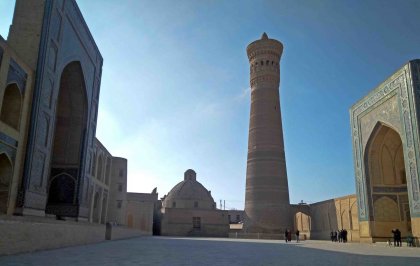World Heritage in Uzbekistan
Outstanding and irreplaceable places to conserve, safeguard, and live.
World Heritage List

©Tatyana Trudolyubova
Bukhara
Historic Centre of Bukhara
Bukhara, which is situated on the Silk Route, is more than 2,000 years old. It is the most complete example of a medieval city in Central Asia, with an urban fabric that has remained largely intact. Monuments of particular interest include the famous tomb of Ismail Samani, a masterpiece of 10th-century Muslim architecture, and a large number of 17th-century madrasas.

©Ona Vileikis
Shakhrisyabz
Historic Centre of Shakhrisyabz
The historic centre of Shakhrisyabz contains a collection of exceptional monuments and ancient quarters which bear witness to the city's secular development, and particularly to the period of its apogee, under the rule of Amir Temur and the Temurids, in the 15th-16th century.

©UNESCO
Khiva
Itchan Kala
Itchan Kala is the inner town (protected by brick walls some 10 m high) of the old Khiva oasis, which was the last resting-place of caravans before crossing the desert to Iran. Although few very old monuments still remain, it is a coherent and well-preserved example of the Muslim architecture of Central Asia. There are several outstanding structures such as the Djuma Mosque, the mausoleums and the madrasas and the two magnificent palaces built at the beginning of the 19th century by Alla-Kulli-Khan.

©UNESCO
Samarkand
Samarkand – Crossroad of Cultures
The historic town of Samarkand is a crossroad and melting pot of the world's cultures. Founded in the 7th century B.C. as ancient Afrasiab, Samarkand had its most significant development in the Timurid period from the 14th to the 15th centuries. The major monuments include the Registan Mosque and madrasas, Bibi-Khanum Mosque, the Shakhi-Zinda compound and the Gur-Emir ensemble, as well as Ulugh-Beg's Observatory.

© IUCN
Tien-Shan
Western Tien-Shan
Jointly with Kazakhstan and Kyrgyzstan
The transnational property is located in the Tien-Shan mountain system, one of the largest mountain ranges in the world. Western Tien-Shan ranges in altitude from 700 to 4,503 m. It features diverse landscapes, which are home to exceptionally rich biodiversity. It is of global importance as a centre of origin for a number of cultivated fruit crops and is home to a great diversity of forest types and unique plant community associations.
World Heritage Tentative List
In addition to the World Heritage inscribed sites, the countries have also a World Heritage Tentative List. These sites are part of an inventory to be considered for nomination in the future. Nominations in Uzbekistan to the World Heritage List will be considered when the nominated property has first been included on the Tentative List of Uzbekistan.
